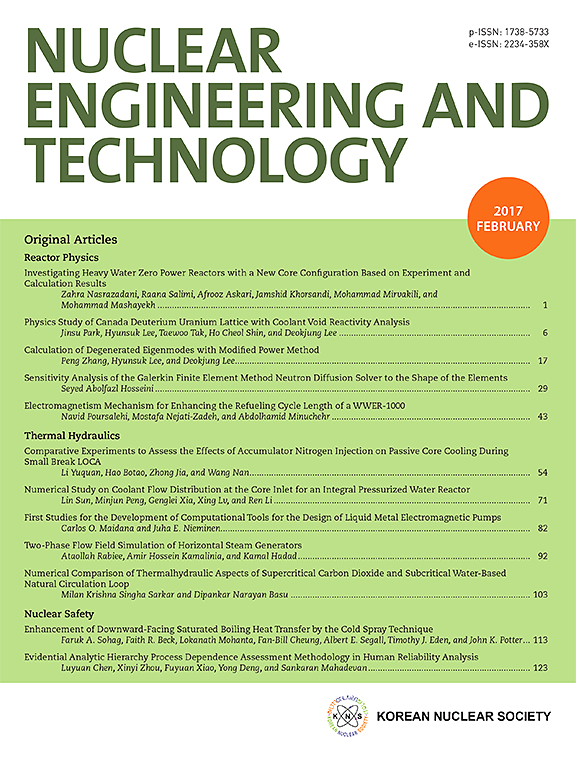Manufacturing B4C-Al dispersion absorber plates using the picture-frame technique
IF 2.6
3区 工程技术
Q1 NUCLEAR SCIENCE & TECHNOLOGY
引用次数: 0
Abstract
The rising global demand for nuclear energy emphasizes the importance of neutron absorber materials, essential for spent fuel storage and other nuclear applications. This study focuses on manufacturing neutron absorber plates using the picture-frame technique, incorporating varying B4C volume contents on an aluminum matrix in the plates' meat. Three configurations were explored, and the plates underwent radiographic, mechanical, microstructural, and neutronic evaluations. The results confirmed the viability of producing neutron absorber plates with reduced dimensions using the picture-frame method. Material properties were comparable to those of commercial neutron absorbers, indicating scalability for larger sizes, and facilitating the eventual deployment of this product. Plates with 45 vol% B4C demonstrated favorable neutron shielding properties, achieving 100 % attenuation in a thermal neutron beam with a 4.0 mm thick B4C-Al dispersion. However, adding B4C to the aluminum matrix caused a decline in mechanical performance, with elongation values around 2 %, making these plates unsuitable for structural use, similar to other commercial materials in this category.
用相框技术制造B4C-Al分散吸收板
全球对核能不断增长的需求强调了中子吸收材料的重要性,这对乏燃料储存和其他核应用至关重要。本研究的重点是使用相框技术制造中子吸收板,在板肉的铝基体上加入不同的B4C体积含量。探索了三种构型,并对钢板进行了射线照相、机械、显微结构和中子评价。结果证实了用相框法生产缩尺寸中子吸收板的可行性。材料性能与商用中子吸收剂相当,表明可用于更大尺寸,并促进了该产品的最终部署。含有45 vol% B4C的板显示出良好的中子屏蔽性能,在4.0 mm厚B4C- al色散的热中子束中实现100%的衰减。然而,在铝基体中添加B4C会导致机械性能下降,伸长率约为2%,使这些板材不适合用于结构用途,类似于该类别中的其他商业材料。
本文章由计算机程序翻译,如有差异,请以英文原文为准。
求助全文
约1分钟内获得全文
求助全文
来源期刊

Nuclear Engineering and Technology
工程技术-核科学技术
CiteScore
4.80
自引率
7.40%
发文量
431
审稿时长
3.5 months
期刊介绍:
Nuclear Engineering and Technology (NET), an international journal of the Korean Nuclear Society (KNS), publishes peer-reviewed papers on original research, ideas and developments in all areas of the field of nuclear science and technology. NET bimonthly publishes original articles, reviews, and technical notes. The journal is listed in the Science Citation Index Expanded (SCIE) of Thomson Reuters.
NET covers all fields for peaceful utilization of nuclear energy and radiation as follows:
1) Reactor Physics
2) Thermal Hydraulics
3) Nuclear Safety
4) Nuclear I&C
5) Nuclear Physics, Fusion, and Laser Technology
6) Nuclear Fuel Cycle and Radioactive Waste Management
7) Nuclear Fuel and Reactor Materials
8) Radiation Application
9) Radiation Protection
10) Nuclear Structural Analysis and Plant Management & Maintenance
11) Nuclear Policy, Economics, and Human Resource Development
 求助内容:
求助内容: 应助结果提醒方式:
应助结果提醒方式:


